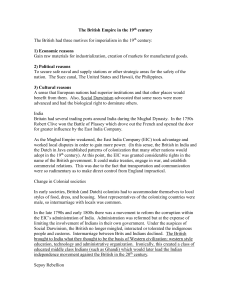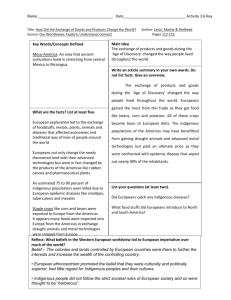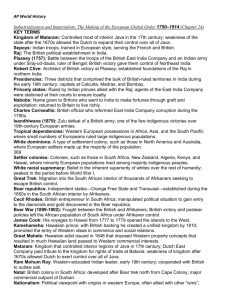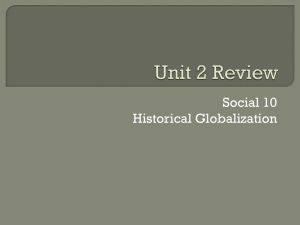chapter 24 - Cherokee County Schools
advertisement
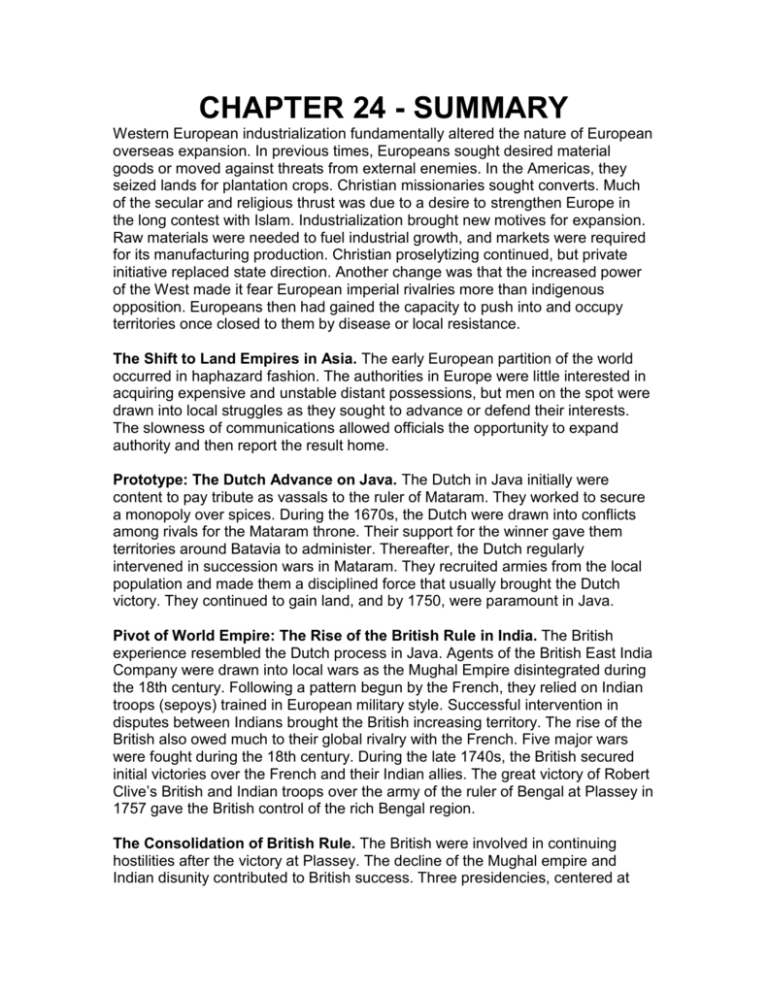
CHAPTER 24 - SUMMARY Western European industrialization fundamentally altered the nature of European overseas expansion. In previous times, Europeans sought desired material goods or moved against threats from external enemies. In the Americas, they seized lands for plantation crops. Christian missionaries sought converts. Much of the secular and religious thrust was due to a desire to strengthen Europe in the long contest with Islam. Industrialization brought new motives for expansion. Raw materials were needed to fuel industrial growth, and markets were required for its manufacturing production. Christian proselytizing continued, but private initiative replaced state direction. Another change was that the increased power of the West made it fear European imperial rivalries more than indigenous opposition. Europeans then had gained the capacity to push into and occupy territories once closed to them by disease or local resistance. The Shift to Land Empires in Asia. The early European partition of the world occurred in haphazard fashion. The authorities in Europe were little interested in acquiring expensive and unstable distant possessions, but men on the spot were drawn into local struggles as they sought to advance or defend their interests. The slowness of communications allowed officials the opportunity to expand authority and then report the result home. Prototype: The Dutch Advance on Java. The Dutch in Java initially were content to pay tribute as vassals to the ruler of Mataram. They worked to secure a monopoly over spices. During the 1670s, the Dutch were drawn into conflicts among rivals for the Mataram throne. Their support for the winner gave them territories around Batavia to administer. Thereafter, the Dutch regularly intervened in succession wars in Mataram. They recruited armies from the local population and made them a disciplined force that usually brought the Dutch victory. They continued to gain land, and by 1750, were paramount in Java. Pivot of World Empire: The Rise of the British Rule in India. The British experience resembled the Dutch process in Java. Agents of the British East India Company were drawn into local wars as the Mughal Empire disintegrated during the 18th century. Following a pattern begun by the French, they relied on Indian troops (sepoys) trained in European military style. Successful intervention in disputes between Indians brought the British increasing territory. The rise of the British also owed much to their global rivalry with the French. Five major wars were fought during the 18th century. During the late 1740s, the British secured initial victories over the French and their Indian allies. The great victory of Robert Clive’s British and Indian troops over the army of the ruler of Bengal at Plassey in 1757 gave the British control of the rich Bengal region. The Consolidation of British Rule. The British were involved in continuing hostilities after the victory at Plassey. The decline of the Mughal empire and Indian disunity contributed to British success. Three presidencies, centered at Madras, Bombay, and Calcutta, directly governed the territories gained. Other regions were controlled through agents at Indian rulers’ courts. By the beginning of the 19th century, India was becoming Britain’s major colonial possession. It contained the empire’s largest colonized population. The willingness of Indians to serve in British-led armies contributed a powerful land force to the empire. Indian ports were vital to British sea power. During the 19th century, India became the major outlet for British manufactured goods and overseas investment, as well as a major supplier of raw materials. Early Colonial Society in India and Java. The Europeans at first were content to leave Asian social systems intact. They formed a new class on top of existing hierarchies. The previous rulers performed most of the daily administrative tasks. The Europeans had to accommodate themselves to indigenous culture in order to survive. They adopted local styles of dress, food, housing, work habits, and political symbols. Since most of the Europeans were men, they lived with and married indigenous women. In Depth: Western Education and the Rise of an African and Asian Middle Class. All European colonizers educated their subjects in Western-language schools. Although colonial rulers had differing ideologies, all needed subordinate personnel to administer their territories. The process had unintended consequences. Unified educational systems gave colonial peoples, who were often not unified, a common language and body of knowledge. The result was a middle class not present in precolonial societies. They became aware of common grievances, while becoming alienated from the traditional social structure of their homelands. They also reacted against the subordination and racism imposed by European rulers. Eventually they began striving to control their own destinies. Social Reform in the Colonies. The British and Dutch were not interested in changing local social or cultural life until early in the 19th century. Rampant corruption among British East India Company officials from the 1770s, which contributed to a disastrous famine in Bengal, forced reform. The company was made more accountable to the British government. More sweeping reforms came during the 1790s; besides reducing corruption and reducing local British officials’ power, they severely constricted Indian participation in the administration. At about the same time, forces building both in Britain and India caused major shifts in policy regarding social reform for subject peoples. The evangelical religious revival worked to end the slave trade and Indian social abuses. Utilitarian philosophers advocated the introduction of British institutions and ideas along with the eradication of social abuses. Both groups agreed that Western education in the English language was the key to reform. The ending of the ritual immolation (sati) of Hindu widows was a particular focus of reform. The reforms enacted were a watershed in global history. A broad range of the essential components of Western culture were introduced into the Indian world. The British wanted to remake Indian society along Western lines. Industrial Rivalries and the Partition of the World, 1870-1914. The ongoing development of the Industrial Revolution increased Western military superiority over the rest of the world. By the end of the 19th century, Western nations were the virtually unchallenged masters of other civilizations. They extracted wealth from overseas possessions and diffused what they considered their superior cultural attributes. At the same time, increased European power augmented economic competition and political rivalries. Britain dominated overseas commerce and empire building during the first half of the 19th century; from then on, Britain was challenged by Belgium, France, Germany, and the United States. Quarrels over colonial spoils contributed to the arms races and alliance formation that culminated in World War I. Unequal Combat: Colonial Wars and the Apex of European Imperialism. By the close of the 19th century, Europeans were the leaders in the ability to make war. Mass-produced new weapons, especially the machine gun, rendered the massed charge suicidal. Railroads and steamships gave Europeans greater mobility. Africans and Asians still fought fiercely against the imperialists, and a few won signal victories or long-delayed conquests. The Zulu, for example, defeated a British force at Isandhlwana in 1879. In general, conventional warfare resulted in indigenous defeat; only guerrilla tactics, as in Vietnam, prolonged, but did not defeat, the European advance. By 1914, all of Africa but Ethiopia and Liberia had fallen to Europeans. In southeast Asia, only Siam was independent. China, Persia, and the Middle East remained unoccupied, but strong informal European political and economic influence was present. Patterns of Dominance: Continuity and Change. The European colonial world had two rough divisions. In most territories in Africa, Asia, and the South Pacific, “tropical dependencies,” and colonies, a few Europeans ruled many indigenous people. Settlement colonies had two divisions. The “white dominions,” such as Canada and Australia, were inhabited mostly by Europeans and their descendants; indigenous peoples were few. They moved toward self-government and parliamentary rule in the 19th century. The second variation, “contested settler colonies,” grouped territories where large European populations lived among even more numerous indigenous peoples. They included South Africa, Algeria, New Zealand, Kenya, and Hawaii. The European and indigenous peoples continuously clashed over control of local resources and questions of social or cultural difference. Colonial Regimes and Social Hierarchies in the Tropical Dependencies. The Europeans drew heavily on past precedents for ruling their millions of subjects. They exploited ethnic and cultural divisions; administrators made the differences more formal by dividing peoples into “tribes.” Minorities, especially Christians, were favored in colonial recruiting. A small number of Europeans, usually living in urban centers, directed administrations. Indigenous officials— some in the highest ranks were Western-educated—worked at local levels. Westernlanguage education in Java and India was supported by the state; in Africa, Christian missionaries often ran the schools. European racial prejudices blocked higher education for most Africans. Asians had more opportunities, but officials there feared the effect of such education and often denied graduates appropriate positions. Such policies greatly stunted the growth of a Western-oriented middle class. Changing Social Relations between Colonizer and Colonized. The growing size and changing makeup of European communities in the colonies were critical factors in the growth of tensions between rulers and the ruled. Europeans increasingly lived in segregated quarters with their families. Relations with indigenous women were not favored. Laws against miscegenation and other opportunities for interaction kept social contact at a minimum. The process was assisted by the peaking of notions of white racial supremacy in the decades before 1914. Africans were put at the bottom of racial hierarchies; they were regarded as savages with little potential for civilized life. Shifts in Methods of Economic Extraction. By the late 19th century, colonial administrators attempted to introduce scientific agricultural techniques and to make their subjects work harder and more efficiently to produce cheaper and more abundant raw materials. Among the incentives employed were the introduction of cheap consumer goods, increased taxation, and harsh forced labor. The economies of most colonies were reduced to dependence on industrialized European nations. Railways and roads were built to facilitate export of raw materials. Mining sectors grew dramatically and vast regions were given over to export crops rather than food. The profits went mainly to European merchants and industrialists. Raw materials went to Europe to be made into products for European consumers. Indigenous workers gained little or no reward. Settler Colonies in South Africa and the Pacific. Contested settler colonies resembled the white dominions in many ways, with parallels to events in Canada and Australia. Settlers arrived in the 17th century in South Africa and in Canada and Australia in the 1840s. Unlike in Canada, the Dutch in Africa and the settlers in Australia did not move far inland for decades. In all three regions they discovered temperate climates and few dangerous diseases. Afrikaners and Australians moved into thinly populated regions and faced much less resistance than did Canadians. Afrikaners enslaved and interbred with the Khoikhoi and San, while the other two groups drove indigenous peoples, who also were hit heavily by European diseases, inland. South Africa. Patterns diverged once the British took control of South Africa. The Afrikaners were culturally different from the British and they resisted British pressure to end slavery. The differences caused many Afrikaners to move inland to regions occupied by Bantu peoples. The struggles between the two produced regional instability that led to British involvement. The Afrikaners formed two interior republics during the 1850s and remained independent until the discovery of diamonds (1867) and gold (1885) renewed tensions that culminated with Afrikaner defeat in 1902. Subsequent British policy placed the majority of the African population under Afrikaner control. Pacific Tragedies. The coming of colonial rule in the South Pacific resulted in demographic disaster and social disruption. The local population lacked immunities to European diseases, and their cultures proved vulnerable to cultural disruption from European goods and values. In New Zealand, the first Europeans, timber merchants and whalers, established themselves among the Maori during the 1790s. Alcoholism and prostitution spread. The Maori suffered from the effects of firearms used in intergroup warfare and from devastating European diseases. The Maoris survived and began to adjust to the effect of the foreigners. They followed European style farming and cut timber for export. Many converted to Christianity. A new contact period commenced in the early 1850s when British farmers and herders arrived. They occupied fertile regions and drove the Maoris into the interior. They faced extinction but instead learned to use the European legal, political, and educational systems to rebuild their culture. A multiracial society evolved that allowed mutual accommodation of cultures. Hawaii was opened to the West during the 1770s. James Cook and later arrivals convinced Hawaiian Prince Kamehameha to accept Western influences and create a unified state. With British help, he won a kingdom by 1810. Kamehameha encouraged Western merchants to export Hawaiian goods in return for increasing royal revenues. Hawaiian royalty began imitating Western ways; female rulers abandoned taboos subordinating women to men. Protestant American Christians won many converts; they changed indigenous customs and established a school system. Westerners introduced diseases that decimated the population, while they exploited the economy by establishing a plantation sugar system. The monarchy encouraged Western businesses and imposed Western concepts for landholding so that property once shared between commoners and aristocrats went to the Hawaiian elite and Westerners. Important population change occurred when American settlers and Asian workers arrived. American planters took advantage of weak rulers after 1872 to press for annexation; the last ruler was deposed in 1893 and Hawaii passed to the United States in 1898. Global Connections: A European-Dominated World Order. Although basic patterns of European colonial domination resembled those of the early industrial period, the style changed considerably by the late 19th century. Racism and social snobbery became pervasive because the colonizers were convinced that they were superior to supposedly inferior races. Officials strove to pull colonized populations into the West’s dominant market system. The policies stimulated unsuccessful resistance movements. Enduring challenges came from among Westerneducated individuals. They integrated strands from their own and Western culture to prepare the way for future resistance to foreign rule. KEY TERMS Kingdom of Mataram: Controlled most of interior Java in the 17th century; weakness of the state after the 1670s allowed the Dutch to expand their control over all of Java. Sepoys: Indian troops, trained in European style, serving the French and British. Raj: The British political establishment in India. Plassey (1757): Battle between the troops of the British East India Company and an Indian army under Siraj-ud-daula, ruler of Bengal; British victory gave them control of Northeast India. Robert Clive: Architect of British victory at Plassey; established foundations of the Raj in northern India. Presidencies: Three districts that comprised the bulk of British-ruled territories in India during the early 19th century; capitals at Calcutta, Madras, and Bombay. Princely states: Ruled by Indian princes allied with the Raj; agents of the East India Company were stationed at their courts to ensure loyalty. Nabobs: Name given to Britons who went to India to make fortunes through graft and exploitation; returned to Britain to live richly. Charles Cornwallis: British official who reformed East India Company corruption during the 1790s. Isandhlwana (1879): Zulu defeat of a British army; one of the few indigenous victories over 19th-century European armies. Tropical dependencies: Western European possessions in Africa, Asia, and the South Pacific where small numbers of Europeans ruled large indigenous populations. White dominions: A type of settlement colony, such as those in North America and Australia, where European settlers made up the majority of the population. Settler colonies: Colonies, such as those in South Africa, New Zealand, Algeria, Kenya, and Hawaii, where minority European populations lived among majority indigenous peoples. White racial supremacy: Belief in the inherent superiority of whites over the rest of humanity; peaked in the period before World War I. Great Trek: Migration into the South African interior of thousands of Afrikaners seeking to escape British control. Boer republics: Independent states—Orange Free State and Transvaal— established during the 1850s in the South African interior by Afrikaners. Cecil Rhodes: British entrepreneur in South Africa; manipulated political situation to gain entry to the diamonds and gold discovered in the Boer republics. Boer War (1899-1902): Fought between the British and Afrikaners; British victory and postwar policies left the African population of South Africa under Afrikaner control. James Cook: His voyages to Hawaii from 1777 to 1779 opened the islands to the West. Kamehameha: Hawaiian prince; with British backing he created a unified kingdom by 1810; promoted the entry of Western ideas in commerce and social relations. Great Mahele: Hawaiian edict issued in 1848 that imposed Western property concepts that resulted in much Hawaiian land passed to Western commercial interests. Mataram: Kingdom that controlled interior regions of Java in 17th century; Dutch East Company paid tribute to the kingdom for rights of trade at Batavia; weakness of kingdom after 1670s allowed Dutch to exert control over all of Java. Ram Mohum Roy: Western-educated Indian leader, early 19th century; cooperated with British to outlaw sati. Natal: British colony in South Africa; developed after Boer trek north from Cape Colony; major commercial outpost of Durban. Nationalism: Political viewpoint with origins in western Europe; often allied with other “isms”; urged importance of national unity; valued a collective identity based on culture, race, or ethnic origin. Short Answer: Compare European imperialism in the initial period after 1450 to the colonial movement between 1750 and 1914. In the early period, with the exception of the Americas, European imperialism was limited to cooperation with local rulers and entry into already established trade systems in Africa and Asia. Slavery and plantation products were important components of the trade. Asian commerce focused on importation of luxuries. Europe had a negative balance of trade with nations such as China because Western products were not valued. The West was not able to enforce its will through force of arms, and missionary efforts had limited effect. The later colonialism accompanied Western industrialization and gave the West overwhelming military superiority. The Europeans shifted from importing luxuries and slaves to importing raw materials; their colonies became important markets for their manufactured goods. Political units dominated by Europeans were created. Missionaries were much more influential. Many more Europeans lived abroad and they had a feeling of racial superiority. Discuss 19th-century imperialism by advancing the viewpoints of an imperialist and a member of a colonized society. Among the many issues that can be discussed here are racism, sexism, Western cultural and religious imposition, economic exploitation, and indigenous reactions to all Western intrusions. Contrast the motives for imperialism in the pre-industrial era with those of the industrial era. Although basic patterns of European colonial domination resembled those of the early industrial period, the style changed considerably by the late 19th century. Racism and social snobbery became pervasive because the colonizers were convinced that they were superior to supposedly inferior races. Officials strove to pull colonized populations into the West’s dominant market system. Describe the use of the Dutch model of control of Java as a model for imperial advance before the 19th century. The Dutch in Java initially were content to pay tribute as vassals to the ruler of Mataram. They worked to secure a monopoly over spices. During the 1670s, the Dutch were drawn into conflicts among rivals for the Mataram throne. Their support for the winner gave them territories around Batavia to administer. Thereafter, the Dutch regularly intervened in succession wars in Mataram. They recruited armies from the local population and made them a disciplined force that usually brought the Dutch victory. They continued to gain land, and by 1750, were paramount in Java. Compare European social interaction with indigenous peoples before and after 1850. Prior to the mid-19th century, the social interaction was very amiable and close. Oftentimes, the Europeans would engage in close ties, even marrying indigenous women. However, that changed because of corruption within trading companies by their employees in the colonies. Also, religious missionaries started to seek conversions. All of these actions forced a distance between the indigenous people and the European counterparts. Identify the motives behind the global scramble for colonies. Among the motives were markets to trade finished goods. Another motive was to find raw materials. Finally, religious conversions served as motive to colonialization. Compare tropical dependencies, white dominions, and contested settler colonies. The European colonial world had two rough divisions. In most territories in Africa, Asia, and the South Pacific, “tropical dependencies,” and colonies, a few Europeans ruled many indigenous people. Settlement colonies had two divisions. The “white dominions,” such as Canada and Australia, were inhabited mostly by Europeans and their descendants; indigenous peoples were few. They moved toward self-government and parliamentary rule in the 19th century. The second variation, “contested settler colonies,” grouped territories where large European populations lived among even more numerous indigenous peoples. They included South Africa, Algeria, New Zealand, Kenya, and Hawaii. The European and indigenous peoples continuously clashed over control of local resources and questions of social or cultural difference. Describe the transformation of 19th-century European imperialists’ methods of economic extraction. By the late 19th century, colonial administrators attempted to introduce scientific agricultural techniques and to make their subjects work harder and more efficiently to produce cheaper and more abundant raw materials. Among the incentives employed were the introduction of cheap consumer goods, increased taxation, and harsh forced labor. The economies of most colonies were reduced to dependence on industrialized European nations.

